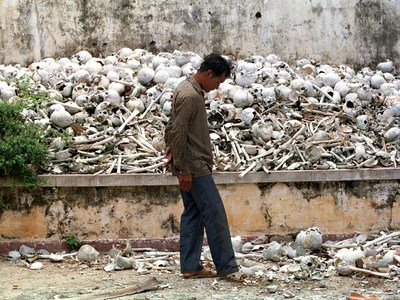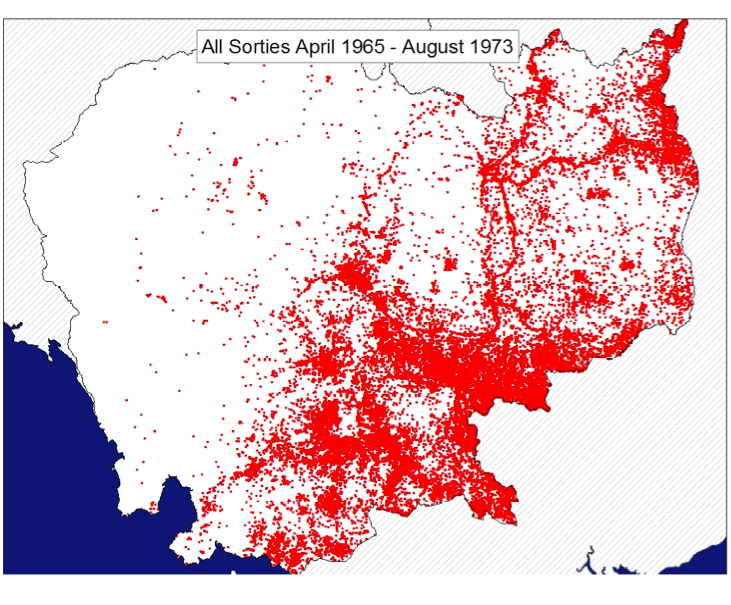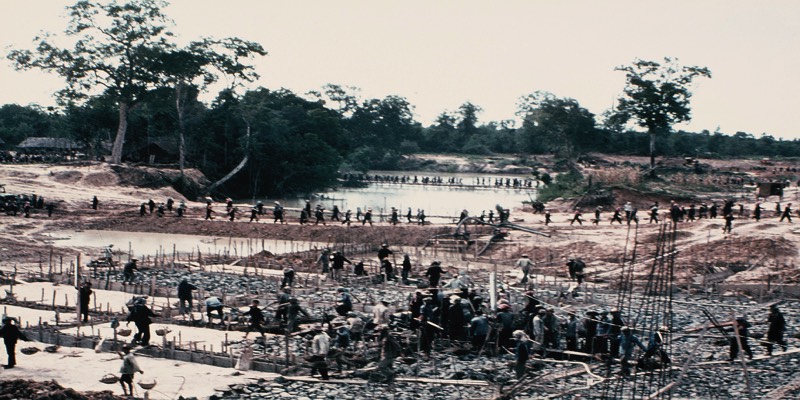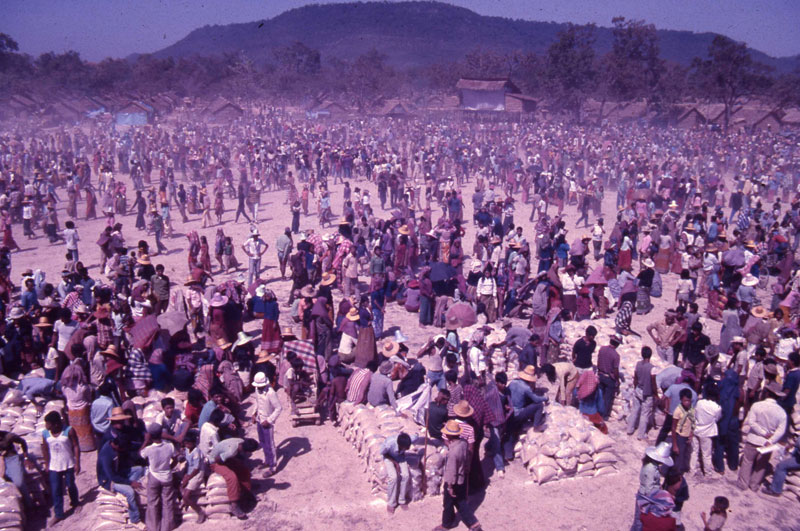4. Cambodia (ATL)

Cambodia was seen as a 'sideshow' to the Vietnam War; however by the 1970s events inside of Cambodia had resulted in the rise of a deadly communist group called the Khmer Rouge whose rule was to lead to the genocide of two million Cambodians.
This page covers events in Cambodia from the fall of Sihanouk through to the collapse of the Khmer Rouge and international response.
Guiding questions
Why did Sihanouk's rule collapse?
What was the impact of the Vietnam War?
What was the ideology of the Khmer Rouge and how was this put into practice?
Why did Vietnam invade Cambodia?
What was the international response to events in Cambodia
There is a graded essay on the reasons for the rise of the Khmer Rouge on this page: 8. Cold War conflicts in Asia: Graded student examples
1. Why did Sihanouk's rule collapse?

Cambodia is flanked by Vietnam and Thailand; both countries had invaded Cambodia many times leaving Cambodians highly distrustful of their neighbours, particularly Vietnam. By the time the French arrived in the mid 19th Century, the Cambodians welcomed French protection.
In 1953, the French allowed Cambodia to gain its independence under the leadership of King Norodom Sihanouk. Sihanouk abdicated as King in 1955 and entered politics. He founded the Sang Kum movement and was appointed head of state after an easy election victory. He had widespread from the peasants who treated him as if he were one of the god-kings from Cambodia's period of greatness.
Task One
ATL: Thinking skills
Watch the following video which was made in 1969 - just before the overthrow of Sihanouk
Make notes on the following:
a. character and political skills and political philosophy of Sihanouk
b. life-style of Sihanouk
c. Reasons why he was so popular amongst his people
d. Relations with its neighbouring states
e. the impact of the Vietnam War on Cambodia at this time
Task Two
ATL: Thinking skills
Read the following account from a text book on Sihanouk's handling of domestic and foreign relations.
- Discuss in pairs whether you think Sihanouk made errors in his political diplomacy or if he was a skillful operator or if, indeed he had little choice in the decisions he took.
Sihanouk tried to follow a neutral policy, both at home and abroad. At home he attempted to keep a balance between left and right wings; however, he had no interest in Communism and he suppressed the small Communist group that developed in the Cambodian jungles. In foreign policy he tried to avoid getting involved in the Vietnam War and to thus to keep good relations between both the Americans and the Chinese - accepting aid from both countries. This was frustrating to the Americans who saw this as a pro-Communist policy rather than one of neutrality. Indeed there are suggestions that from 1959, the CIA were trying to undermine Sihanouk.
Following the assassination of Diem in Vietnam, Sihanouk broke relations with the Americans fearing similar treatment. He also believed that the Communists would win in Vietnam and so wanted to keep good relations with them. He fostered good relations with China and also allowed Vietnamese Communists to set up bases in Cambodia - provided Cambodia's borders were respected. However, this new situation was disliked by those Cambodians who had benefited from American aid - particularly Army officers. To quell this discontent, Sihanouk appointed the strongly anti-communist General Lon Nol as Prime Minister. Lon Nol clamped down harshly on left-wingers who then joined the guerillas in the jungle. Sihanouk also tried to rebuild relations with the Americans and ignored the massive bombing on the Cambodia by the Americans which forced the communists deeper into the jungles of Cambodia.
Protests against the presences of an estimated 40,000 Vietnamese communists were encouraged by Lon Nol who then seized power from Sihanouk while Sihanouk was out of the country, on holiday. The United States immediately recognised Lon Nol's government. In response, Sihanouk called for the formation of a United Front. He called for his supporters to go to the jungle to fight the government, which was in fact a declaration of support for the Khmer Rouge. There was now civil war in Cambodia.
2. What was the impact of the Vietnam War?
Note: also see the video Vietnam: A television War on the video page for a good overview of the impact of the US on events: 6. Cold War conflicts in Asia: Videos and activities

Map showing sites of bombing in Cambodia, 1965 - 1973
‘I believe that the actions of President Nixon and Henry Kissinger in dragging Cambodia into the war were criminal’
Bowden, One crowded hour
In 1968, Nixon was elected President in the US with the aim of achieving "Peace with Honour' in the Vietnam War. He planned to pull out US troops and get the Vietnamese army to do more of the fighting (Vietnamisation). He also carried out peace talks. However, he also escalated the war by carrying it into Cambodia.
In March 1969, President Nixon authorised secret bombing raids in Cambodia against Viet Cong headquarters (COSVN) thought to be in Cambodia. These ‘secret’ bombings (Operation Menu) were to last 14 months. The result of these bombings was to push the Vietnamese Communists further into Vietnam
When Lon Nol took over as President, a civil war situation developed in Cambodia. 30 Paris 1970, Nixon announced the invasion of Cambodia by US and ARVN troops to destroy Communist bases. This forced the Communists further into Cambodia. Support for the Khmer Rouge increased amongst the Cambodian peasants who were increasingly disturbed by the US bombing and by the actions of the ARVN troops. They also despised Lon Nol’s government which was corrupt and inefficient and reliant on the US
By July 1970 the Khmer Rouge with North Vietnamese support, occupied over half the country.
Over next few years the Cambodian army lost territory against the North Vietnamese and communist Khmer Rouge guerrillas and in 1975 Pol Pot and the Khmer Rouge took over Phenom Penh. It was now 'Year Zero' and Cambodia became known as Democratic Kampuchea.
Task One
ATL: Thinking skills
Read this explanation from Nixon on the US bombing.
What, according to Nixon, was the justification for the US bombing of Cambodia?
The bombing of the North Vietnamese sanctuary areas in Cambodia…was not from a desire to expand the war, but to avoid bombing North Vietnam..the issue concerned territory which was no longer Cambodian in any practical sense. For four years, as many as four North Vietnamese divisions had been operating on Cambodian soil…they would launch attacks across the border into South Vietnam, inflict casualties, disrupt government, and then withdraw to the protection of a formally neutral country’
Task Two
ATL: Self-management, research and thinking skills
Work in pairs. One student should write a speech defending the bombing of Cambodia. The other student should write a speech condemning it.
This article from the New York Times will give you a starting point for the arguments for and against the bombing.
Task Three
ATL: Thinking and self-management skills
Review the information above on Sihanouk and the actions of the US. Create a mind map to show why the Khmer Rouge was able to succeed in Cambodia.
The role of the Khmer Rouge can be completed after you have done the next section on this page. Keep adding to your mind map as you find out extra information e.g from the videos which can be found here: 6. Cold War conflicts in Asia: Videos and activities
The following should be part of your mind map:
- Actions of Sihanouk
- Actions of Lon Nol
- US bombing
- Vietnamese communists
- Khmer Rouge
3. What was the ideology of the Khmer Rouge and how was this put into practice?

The rice fields of the Khmer Rouge
'Communist aspects of Khmer Rouge ideology and practices also combined disastrously with more indigenous features of the regime. These included territorial expansionism; racial and other social discrimination and violence; rhetorical idealization fo the peasantry; repression of commerce and cities in favor of autarky; communalism; and assaults on the family'.
This quote from Odd Westad's book, The Third Indochina War: Conflict Between China, Vietnam and Cambodia, 1972-79, (which can be found here) stresses that many of the characteristics of Khmer Rouge ideology came from 'long-standing Khmer cultural and historical forces'. Some of the key characteristics of Khmer Rouge ideology were as follows:
- A stress on the previous power and glory of Cambodia. The DPK launched attacks against all three of its neighbours and looked to reunite Cambodia with previously Khmer speaking areas. This involved hardening the population to violence and also stirring up patriotic sentiment regarding long-lost territories
- Racism and violence against Vietnamese had been a key component of Khmer ideology and it existed in the DPK alongside communism. The majority of DK's victims were from Cambodia's ethnic Khmer majority but ethnic minorities were specifically targeted; use of minority and foreign languages was banned. The DPK carried out genocide against the Vietnamese and virtually all of Cambodia's 10,000 Vietnamese citizens were killed. In May 1978, the Khmer Rouge called on people to 'purify' the 'masses of the people' of Cambodia. 'Xenophobic racism, expansionism, and massive slaughter all went hand in hand'. (Westad, pg 189)
- An emphasis on the peasants as the true 'national' class. 'Base' people were the ethnic Khmer peasants and 'New' people came form the towns which meant that they had been contaminated by foreign and capitalist influence. All Cambodians forced into the countryside where huge new rice fields were created. However, this involved destroying the traditional peasant plots as well as Buddhism and the family unit. Thus, 'while the Khmer idealised the peasantry and liked to say they were leading a peasant revolution, they destroyed the Khmer peasant's way of life' (Westad)
Task One
ATL: Thinking skills
What can you learn from the following source about Khmer Rouge ideology?
Orders from Khmer Rouge Leaders on taking control of Phenom Penh:
1. Evacuate people from all towns
2. Abolish all markets
3. Withdraw the Lon Nol currency, but withhold the revolutionary currency which had been printed
4. Defrock all Buddhist monks, and put them to work growing rice
5. Execute all leaders of the Lon Nol regime, beginning with the top leaders
6. Establish high-level cooperatives throughout the country, with communal eating
7. Expel the entire Vietnamese minority population
8. Dispatch troops to the country's borders, particularly the border with Vietnam
Task Two
ATL: Thinking skills
Read this article by Sydney Schanberg, written for the New York Times, on the take-over of Phnom Penh
- What made this event ‘an astonishing spectacle’?
- What else can you learn from this article regarding the ideology and actions of the Khmer Rouge?
Note you should watch the Oscar winning film The Killing Fields which is based on the true story of Sydney Schanberg's experiences and those of his friend, Dith Pran, a Cambodian journalist - it will give you an invaluable insight into the horrors of the Khmer Rouge regime
Task Three
ATL: Research and communication skills
In pairs or small groups research further:
a. the ideology of the Khmer Rouge
b. the policies that they implemented in order to implement their ideology. This will include investigating the horrors that took place at Tuol Sleng prison.
c. The impact of their policies
Either create a PPT presentation of your findings or a visual display. Include images and quotes from the DPK and quotes from survivors.
These websites will help you:
Cambodia website, 'A nightmare in blood'
Holocaust memorial: Khmer ideology
The digital archive of Cambodia Holocaust Survivors (DACHS)
In addition watch the two excellent videos on the Khmer Rouge on this page: 6. Cold War conflicts in Asia: Videos and activities as well as the movie The Killing Fields (see note above on this)
Task Four
ATL: Communication and thinking skills
Hot seating: students should take it in turns to take on the role of Sihanouk, Lon Nol, Pol Pot and Nixon.
Each character will face questions from the class regarding his role in creating the genocide; they have to justify their actions.
4. Why did Vietnam invade Cambodia?

Refugee camp for Cambodians on the Thai border during the Vietnamese invasion and occupation
The Khmer Rouge period was dominated by terror and paranoia. Pol Pot aimed to secure his position against all threats, real or otherwise. The greatest threat he perceived as coming from the Cambodian’s traditional enemy: the Vietnamese. Following several border attacks from the Khmer Rouge into Vietnam, Vietnam launched a full-scale invasion of Kampuchea in late December 1978. Phnom Penh fell on 7 January and Khmer Rouge leaders fled to the jungle where they continued a guerrilla war against the Vietnamese. Cambodia was now renamed People's Republic of Kampuchea.
There were several reasons for this conflict:
- Ideological differences. The Khmer Rouge supported a Maoist from of peasant Communism whereas the Vietnamese followed Soviet style communism
- Sino-Soviet rivalry: the Soviets supported Vietnam where as China supported the Khmer Rouge; there was rivalry between the Chinese and the Soviets and China was concerned that it would be surrounded by the Soviets and their allies
- The desire of Pol Pot to revive the glories of the Angkor Empire
- Conflict over islands in the gulf of Thailand
- The Khmer Rouge’s resentment at the use that Cambodian territory had been put during the war
- Cambodian fear that Vietnam was aiming to bring all of Indo China into an Indochinese Federation controlled by Vietnam
- During 1977 and 1978, the Khmer Rouge carried out a series of brutal attacks across the border into Vietnam which resulted in approximately 30 000 Vietnamese being killed
Task One
ATL: Thinking skills
In pairs discuss the reasons for conflict between Vietnam and Cambodia.
Which reasons do you think were most significant for Vietnamese invasion of Cambodia?
Task Two
ATL: Communication skills
Write a speech from a Khmer rouge leader in which you justify to the Cambodian people the need to prepare themselves for a war with Vietnam.
5. What was the international response to events in Cambodia?

The Paris Peace Accords signed by 19 countries and included the formation of UNTAC
Although the invasion of Kampuchea by the Vietnamese ended the genocide and the horrors that the people were suffering, Vietnam was largely condemned by the rest of the world, and indeed faced invasion itself. Even the United Nations voted to recognise the Khmer Rouge as the legitimate government of Kampuchea. Cold War politics also played a key role. The USSR and China were hostile to each other at this point and China and the USA were having a period of improved relations. on one side was the Soviet Union, Vietnam, the Soviet Bloc countries and the new Cambodian government led by Hang Samrin; on the other side were China, United States, Thailand, Singapore and most other western countries.
Task One
ATL: Thinking skills
In pairs discuss why the following countries were hostile towards the Vietnamese action. Click on the eye for possible answers
- United States
- Thailand
- ASEAN nations
- Australia
United States: having been defeated in Vietnam War - they could not tolerate any increase in Vietnamese power
Thailand: It saw itself as the dominant economic power in Indo China, and felt that Vietnam could pose a threat to its powers
ASEAN nations: They were concerned that Vietnamese expansion could increase the role of the Soviet Union (which supported Vietnam as opposed to China who supported Kampuchea) and were worried about the emergence of a Vietnam as a strong Communist power with the USSR as its ally.
Australia: Australia went along with the policy of the US and stopped all aid to Kampuchea
The removal of the Khmer Rouge did not immediately improve the lives of the people. There was famine in 1979 and many fled to the Thai border where refugee camps were established. The international community finally realised the extent of the famine and sent aid thought they were reluctant to send this to Phnom Penh and the Vietnamese. Much was sent to the border camps where a huge smuggling operation was started to get the food into Cambodia.
The camps were controlled not just by the smugglers but also by the Khmer Rouge who used the as a base to continue to fight against Heng Samrin's government. Thus UN aid going to the camps effectively supported the Khmer Rouge.
Although the Vietnamese were greeted as saviours by many Cambodians when they arrived in 1979, the longer the Vietnamese stayed, the more they were seen as invaders, especially as 200,000 Vietnamese troops remained; such a view was promoted by the US and the UN. Many Vietnamese also moved into Cambodia thus reviving ancient fears of Vietnamese expansion.
The Vietnamese finally withdrew in 1989. this was due to several reasons:
- A suffering Vietnamese economy
- The impact of Perestroika in the Soviet Union which meant that the Soviets could no longer afford to pay for Vietnam's war in Cambodia
- Promises from the US that it would start diplomatic relations with Vietnam if it withdrew; Vietnam hoped that the ending of diplomatic isolation would also lead to trade agreements
- Vietnam felt that the Khmer Rouge were no longer strong enough to take over Cambodia
- Vietnam had already suffered severe casualties as a result of the invasion: 55 000 dead and 60 000 wounded
A temporary coalition government was formed and in 1991 a peace agreement was signed between opposing parties. Elections were set for 1993, and the former monarch, Prince Sihanouk, was elected.
Pol Pot led the Khmer Rouge as an insurgency until 1997 when he was arrested and placed under house arrest. The organization continued to exist until 1999, by which point most members had defected, been arrested, or died.
Task One
ATL: Thinking skills
Read this article from the BBC website on the Vietnam invasion, 'Vietnam's forgotten Cambodian War'.
Why are parallels drawn between this war and the American/Vietnam War?
Task Two
ATL: Thinking skills
In pairs discuss the impact of the Cold War on events in Cambodia
Task Three
ATL: Thinking skills
Read this article from The Phenm Penh Post on the UN involvement in Cambodia.
What points does it make (a) in favour of and (b) against international actions and the role of the UN in Cambodia.
Task Four
ATL: Self-management skills
Complete the attached grid to review the changing governments in Cambodia
ATL: Self-management Skills
Make a timeline from 1955 to 1979 to show the key events in Cambodia.
On one side mark on events from foreign countries that impacted on Cambodia.
On the other side of the timeline mark on events carried out by the Cambodian government

 IB Docs (2) Team
IB Docs (2) Team
